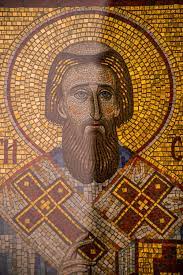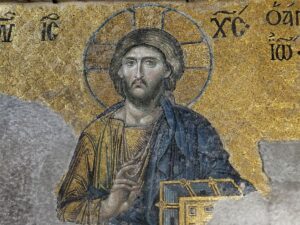Byzantine art is a visually rich style that emerged from the heart of the Byzantine Empire, captivating viewers with its spiritual depth and intricate beauty.
It’s a fusion of religious iconography, lavish materials, and bold colors, a testament to the era’s cultural sophistication.
In this article, we’ll jump into the origins, characteristics, and lasting impact of Byzantine art, uncovering the stories behind the mosaics and icons that still inspire awe today.
Join us as we explore the transcendent world of Byzantine creativity, where each piece isn’t just art—it’s a piece of history.
Origins Of Byzantine Art
The bedrock of Byzantine art traces back to the vast and potent Roman Empire.
With the division of the empire in the 4th century, the Eastern Roman Empire, known as the Byzantine Empire, cultivated its unique artistic language.
We see this transformative period lay the groundwork for a new visual culture that blended the classical Greco-Roman traditions with Near Eastern and Christian influences.
Byzantine art emerged distinctly around the 5th century, establishing an aesthetic staple for over a millennium.
Our exploration into this era reveals a keen intertwining of religious and political symbolism, as the state and the church were deeply interconnected.
The capital, Constantinople, became a cultural hub where arts flourished, boasting masterpieces such as the mosaics in Hagia Sophia.
Key inflection points marked the maturation of Byzantine art:
- The Iconoclastic Controversy during the 8th and 9th centuries, a period of turmoil About the veneration of images, led to a renewed vigor in iconography post-controversy.
- A resurgence in artistic production was seen in the Middle Byzantine period, after the restoration of icons, which solidified the visual language of spirituality in art.
- The Late Byzantine period saw an increase in artistic exchange with the West and a subtler, more expressive style in artwork.
As filmmakers and creative professionals, we appreciate the storytelling prowess inherent in Byzantine art.
The narrative frescoes and intricate mosaics are not unlike the visual storytelling through set designs and cinematography in our field.
Each frame of a film, much like every segment of a Byzantine mosaic, can convey a story’s ethos, transcending time and language barriers.
Characteristics Of Byzantine Art
One of the most prominent features of Byzantine art is its ethereal quality.

The flat, two-dimensional figures and gold backgrounds commonly found in Byzantine mosaics and paintings are not attempts at realism but aim to depict a divine or otherworldly realm.
This stylistic choice creates a timeless aura, an element that we in filmmaking strive to infuse in period pieces to transport viewers across epochs.
plus to its transcendental characteristics, Byzantine art is known for its adherence to traditional themes and patterns.
Artists often replicated established iconographic formulas, much like how film genres adhere to certain tropes for familiarity.
Works such as the Hagia Sophia’s mosaics are as much about conveying theological principles as they are about artistic expression.

- Use of rich color,
- Emphasis on narrative,
- Extensive use of icons and symbols.
The craftsmanship involved in Byzantine art cannot be overstated.
The intricate iconostasis found in churches displays a mastery of medium that has inspired set design and costume detailing in historical films.
The careful application of tesserae in mosaics parallels the meticulous composition we achieve through cinematography.
Textiles and architectural elements showcase a persistent interplay of patterns and textures, influencing visual storytelling where textures convey a deeper context.
The sumptuous fabrics and elaborate mosaics also speak to a culture that valued visual splendor, akin to the lush visuals we craft in high-budget epics.
eventually, the multisensory experience of Byzantine art—with its interweaving of visual opulence and spiritual depth—resonates deeply with our own goals in filmmaking.
It’s about creating immersive worlds that captivate and move audiences, whether they’re stepping into a medieval chapel or a movie theatre.
Iconography In Byzantine Art
Iconography, or the visual imagery and symbols used in Byzantine art, shares a profound connection to the spiritual and theological concepts of the time.
The extensive use of icons served not only as religious decoration but also played a pivotal role in deepening the faithful’s understanding of the sacred.
Depictions of divine figures and saints were not merely artistic expressions but visual teachings of Christian dogma and scripture.
Every aspect of Byzantine iconography was laden with symbolism.
Specific colors, gestures, and even the positioning of figures carried distinct meanings and conveyed theological messages.
For instance:
- Gold often symbolized the divine light of heaven,
- A raised hand might denote blessing or authority,
- The configuration of saints and angels communicated their hierarchical significance.
Over time, the iconographic style evolved, yet its core purpose remained—acting as a gateway to the divine for believers.
Iconography also became an invaluable storytelling tool, akin to how we use cinematography to convey deeper meanings without dialogue.
The mastery of visual narrative seen in Byzantine mosaics or frescoes is comparable to the techniques employed by modern film directors to relay complex stories visually.
Byzantine iconography stretches beyond mere aesthetics; it is a language unto itself.
Like any language, its nuance and depth can take a lifetime to fully appreciate.
As filmmakers and admirers of visual storytelling, we recognize the craftsmanship involved in communicating profound ideas through imagery.
In every piece of Byzantine art lies a storyboard of spiritual significance, resonating with viewers across centuries.
Materials And Techniques In Byzantine Art
Byzantine art is renowned for its luminous mosaics and opulent adornments.
At the heart of these creations was a mastery of materials and an innovation of techniques that defined the era.
We observe gold leaf and glass tesserae imparting a divine glow to iconic pieces, as seen in the Hagia Sophia.
These materials were not only chosen for their beauty but also for their symbolic resonance, with gold often representing the heavens and the divine.
The processing of materials was meticulous, utilizing time-honored methods to achieve precision and permanence.
For instance:
- Gold leaf was hammered into thin sheets and applied with expertise to icons and mosaics.
- Glass tesserae were cut and colored with metallic oxides before being set into walls or ceilings in intricate patterns.
Painting in Byzantine art followed a similarly disciplined process, where artists often applied tempera onto wood panels.
Egg yolk, mixed with pigment, created a durable and vivid paint that has stood the test of time.
This technique allowed for a rich depth of color and fine detail in the portrayal of holy figures and scenes.
Frescoes too played a significant role in decorating churches, with wet plaster offering a medium that captured the vibrant pigments as they dried.
The skillful employment of enamel on religious items, such as icons and reliquaries, also marks the innovative nature of Byzantine craftsmanship.
Multi-colored enamel pieces were fired to produce a glossy finish that mimicked the appearance of precious stones.
As we jump into the creative complexities behind Byzantine art, we find that these techniques weren’t mere methods of construction but a language speaking volumes about the spirituality and sophistication of the era.
Impact And Legacy Of Byzantine Art
Byzantine art has had a profound impact on the development of visual culture and aesthetics throughout history.
Its influence extends beyond its own era and can be seen in the subsequent art movements, particularly in Italy where it served as a foundation for the early renaissance.
The hallmark of this legacy is evident in the works of artists like Cimabue and Duccio, who transitioned from the Byzantine style into more naturalistic forms.
In the realm of religious architecture and iconography, Byzantine art’s significance is monumental.
Churches across Europe, especially those in the Orthodox tradition, continue to employ the characteristic styles of iconography that were perfected during the Byzantine Empire.
Their art becomes a tool for spiritual connection, conveying narratives and theology without relying on textual explanations.
- Influence on Modern Design – Use of geometric patterns – Emphasis on ornamental richness – Integration of symbolic elements.
The cinematic landscape too bears a trace of Byzantine aesthetics, especially in the genre of historical epics.
The grandeur and solemnity of Byzantine mosaic scenes can be perceived in the backdrops and settings of films set in antiquity or the Middle Ages.
A notable example is Gladiator, where the architecture and imperial iconography draw clear parallels to Byzantine sensibilities.
Besides, contemporary fashion and interior design periodically revisit Byzantine motifs, proving the timeless appeal of its intricate patterns and color palettes.
Designers often reference the luxurious textures and shimmering surfaces that were staples of Byzantine art, bringing a touch of historical splendor to modern style.
Our fascination with Byzantine art lies not only in its historical significance but in the continuous inspiration it provides across various creative disciplines.
What Is Byzantine Art – Wrap Up
We’ve journeyed through the rich tapestry of Byzantine art, uncovering its enduring influence across cultures and centuries.
Our exploration reveals that this artistic tradition isn’t just a relic of the past but a living inspiration that continues to resonate in contemporary creative fields.
From the divine glow of ancient icons to the echoes of its aesthetic in today’s design, Byzantine art’s legacy is as vibrant as the mosaics it’s renowned for.
It’s clear that the stories once told through gilded imagery on church walls still captivate us, proving that beauty truly is timeless.
Frequently Asked Questions
What Is Byzantine Art?
Byzantine art refers to the body of Christian Greek artistic products of the Eastern Roman (Byzantine) Empire, as well as the nations and states that inherited culturally from the empire.
Known for its ethereal quality, it remained consistent in traditional themes and patterns, making extensive use of icons and a rich color palette.
How Did Byzantine Art Use Color And Narrative?
Byzantine art distinctive for its use of rich, vibrant colors, contributing to its ethereal and otherworldly aesthetic.
It placed a strong emphasis on narrative, using detailed scenes and religious iconography to tell stories and convey spiritual messages.
What Are Icons In Byzantine Art?
Icons are religious works of art in Byzantine culture, typically paintings, that are venerated among Eastern Orthodox, Oriental Orthodox, and to some extent Eastern Catholic Churches.
They hold significant spiritual importance and are characterized by their elaborate symbolism and stylized form.
What Is An Iconostasis?
An iconostasis is an elaborately decorated partition, often made with wood and covered with icons, that separates the nave from the sanctuary in a Byzantine church.
Its intricate craftsmanship is a hallmark of Byzantine artistic and religious tradition.

How Does Byzantine Art Relate To Filmmaking?
Both Byzantine art and filmmaking share the ability to tell stories through visual narratives.
Byzantine artworks utilized narrative scenes and symbolic imagery to immerse the viewer, a technique akin to the captivating visual storytelling found in cinema.
What Is The Legacy Of Byzantine Art?
The legacy of Byzantine art includes its influence on later art movements, architecture, and iconography, especially in religious contexts.
Its aesthetics, with their intricate patterns and color palettes, have also made a lasting impact on modern design, fashion, and interior design.
How Does Modern Design Draw Inspiration From Byzantine Art?
Modern design draws inspiration from Byzantine art through the adoption of its intricate patterns, luxurious textures, and vivid color palettes.
These elements are reflected in contemporary fashion, interior design, and various other creative disciplines.


